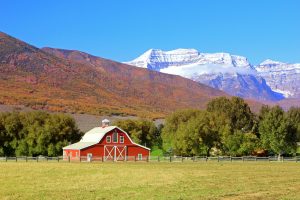Take These Five Hidden Costs Off the Table

Those of us in the authentic food and ecological farming tribe often cite externalized costs as one of the failings of the agri-industrial farming complex.
We point out that the cheap price of food at the cash register does not cover all sorts of things: half of all diarrhea cases, 700 riparian dead zones (the largest of which is the size of Rhode Island in the Gulf of Mexico), superbugs like MRSA and C. diff, antibiotic resistance, asthma for neighbors…
Oh, and animal abuse, health problems for workers, soil erosion…
The list is long and glorious to recite. I’ve done it many times in media interviews.
We had a visitor on the farm the other day. After walking around, he mentioned externalized benefits.
He pointed out that the gains our farming system brings to the table are just as important to talk about as the costs of the industrial model.
So let’s drill down on the benefits of our approach.
5 Benefits of the Polyface Model
1. Soil Health
Civilizations rise and fall according to the health of their soil.
The only thing between survival and starvation is a thin layer called soil. Agronomists like to say that if the Earth were an orange, the soil would be thinner than the yellow pigment on the orange peel.
To be healthy, soil needs to be covered (with vegetation), left alone (not tilled), fed carbon (not chemical fertilizer) and biologically active (with worms and microbes).
The supposed green revolution destroyed more soil faster than anything in history. Carbon-centric compost and perennials benefit soil development.
[mw-adbox]
2. Nutrition
Pasture-based livestock and compost-fertilized gardening offer the most balanced and nutrient-dense food for our diet.
Grass-finished beef has 300% more riboflavin than grain-finished. In only two weeks of grain feeding, all the conjugated linoleic acid leaves a beef animal. The nutritional benefits are literally incalculable.
Pastured eggs from our farm contain 20 times the folic acid of factory farmed eggs. That’s not a percentage; it’s a magnitude. This is not uncommon.
The Bionutrient Food Association has found the same magnitude of difference between a carrot grown in fertile soil versus one grown in chemical soil. You’d have to eat 100 of the poor carrots to get the same nutrition as just one of the good ones.
As spectrometer technology becomes cheaper, nutritional punch can be tested and verified from a smartphone.
3. Wildlife
The scorched-earth policy of the industrial farming sector views wildlife as a liability rather than an asset.
In a diversified, symbiotic pasture-based system, wildlife is an asset. That doesn’t mean we don’t deal with the occasional predator or that we don’t hunt. It means we don’t view wild ducks landing on the pond as enemies.
The official USDA position right now is that ponds are liabilities because they attract waterfowl to farms. It insists that these waterfowl transmit avian flu and threaten the nation’s poultry industry.
At our farm, we dare to suggest that our livestock’s immune system is strong enough to withstand whatever pathogens float around in the great universe.
Our farm has all eight species of bumblebees known to exist in Virginia. That’s because our pastoral mosaic has a variety of perpetual blooms somewhere, offering a constant buffet to pollinators. Farms that grow only a single type of crop don’t offer that.
As Michael Pollan observed during his week’s visit when writing The Omnivore’s Dilemma, our farm exuded an abundance of life. That’s wildlife, people, insects, worms and fireflies.
4. Animal Welfare
The ethical approach in protecting the “pigness” of the pig has profound consequences. The mechanistic and industrial U.S. conventional farming orthodoxy views life as fundamentally inanimate, no more sacred than a copper plumbing fitting or plastic doll.
This cheapens life. Defending the pigness of the pig elevates life and creates value for individual differences. A culture that does not honor the pigness of the pig will soon not honor the Tomness of Tom or the Maryness of Mary… or the Pakistaniness of Pakistan.
By protecting and honoring the few and those who can’t speak for themselves, we create an ethical framework that protects the rights and aspirations of people. We view life as fundamentally biological rather than mechanical. A society benefits profoundly from this mindset.
5. Succession
Right now, the average farmer is 60 years old. In the next 15 years, half of all American agriculture equity will change hands. If young people can’t get in, old people can’t get out. Both generations are stuck.
So any model that allows farm assets and skills to be passed down over generations brings valuable benefits to the culture.
Perhaps one of the biggest benefits of Polyface-style farming is that it lowers the barrier to entry. If you want to grow chickens for Tyson, you need a half-million-dollar factory house. If you want to grow pastured chickens, you can start with a $300 mobile shelter.
And by encouraging direct marketing in a new retail space, we break the bondage of commodity pricing. Based on our apprentice program, I’m convinced we’d have thousands of young people ready to become farmers if they thought they could make a living. Owning and marketing your own brand is a way to do that.
My new challenge is to talk about our farm’s externalized benefits at least as much as I rip into the externalized costs of the agri-industrial complex.
Sugar always attracts more people than vinegar.
Sincerely,
Joel
Like what you’re reading? Let us know your thoughts here.






